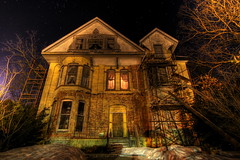It’s a lot easier to create an emotional response in readers by using your characters’ emotions. But not every scene and not every description is going to lend itself to a character’s viewpoint. Often we see scenes (or books) that start with an almost panoramic view of the setting, as if we’re sweeping through the scene with a movie camera. There aren’t any characters in view, or no characters who can make emotional and perceptual judgments to guide our readers’ responses.
However, we can still use the setting to establish the emotional tone. Instead of relying on a character’s emotional responses and filter to create the tone, we can try to evoke the same emotion directly with the imagery from the scene.
While this technique can be more direct, it can also be a bit more difficult. Manipulating readers’ emotions directly—without getting caught—is a tricky business. (Or maybe I’m just too sensitive—I even resent TV commercials for emotionally manipulating me.)
Obviously, one of the methods you can use to set the emotional tone is imagery. Picking the right image is key, too: focusing on a gray bunny hopping along the forest trail instead of the finger-like, grasping shadows of the trees will undermine the scary tone you’re shooting for. Even if the bunny is important—a “clue,” something you need for later—we have to frame that in the right emotions. Perhaps it skitters nervously down the path, fleeing something unknown, or perhaps we only perceive it as a rustling in the leaves.
Personally, I still prefer using characters as a vehicle for this: by giving them the emotional responses we desire in our readers, we can create those responses more subtly and more easily. But maybe using our characters just helps us to focus our emotional effects, and with care, we can create a tone just as powerfully as we can through our characters.
What do you think? How can we set an emotional tone with a setting, and without characters?
Photo by Hamed Saber







 I know some people do just that—spend hours, days or even months designing a character and bringing him or her to life, tweaking every last nuance of his or her backstory, weaving it into the plot outline, crafting quirks, homing in on weaknesses—all before they start writing a word of the first draft.
I know some people do just that—spend hours, days or even months designing a character and bringing him or her to life, tweaking every last nuance of his or her backstory, weaving it into the plot outline, crafting quirks, homing in on weaknesses—all before they start writing a word of the first draft. 